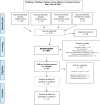Trapeziectomy for trapeziometacarpal osteoarthritis
- PMID: 33650434
- PMCID: PMC8009903
- DOI: 10.1302/2633-1462.23.BJO-2020-0188.R1
Trapeziectomy for trapeziometacarpal osteoarthritis
Abstract
Aims: The objective of this systematic review was to describe trapeziectomy outcomes and complications in the context of osteoarthritis of the base of the thumb after a five-year minimum follow-up.
Methods: Preferred Reporting Items for Systematic Reviews and Meta-Analyses (PRISMA) guidelines were used to guide study design, and 267 full-text articles were assessed for eligibility. After exclusion criteria application, 22 studies were included, involving 728 patients and 823 trapeziectomies. Outcomes included pre- and postoperative clinical and radiological characteristics. Complications and revisions were recorded.
Results: All the studies reported good results regarding pain and range of motion at the last follow-up of 8.3 years (5 to 22); the mean satisfaction rate was 91% (84% to 100%). It was difficult to assess the impact on metacarpophalangeal joint motion in extension with contrary results. The key pinch returned to its preoperative values, whereas tip pinch showed a modest improvement (+14%), with a mild improvement found in grip strength (+25%) at the last follow-up. The mean progressive trapezial collapse was 48% (0% to 85%) and was not correlated with pain, grip strength, or satisfaction. The most represented complications were linked to tendons or nerves affected during additional procedures to stabilize the joint (11.6%; n = 56). Mechanical complications included symptomatic scapho-M1 impingement (3.1%; n = 15/580), leading to nine surgical revisions out of 581 trapeziectomies. Meta-analysis was not possible due to study heterogeneity and limited data.
Conclusion: After a minimum five-year follow-up, trapeziectomy achieved high patient satisfaction and pain relief. However, strength seemed to be deteriorating with detrimental consequences, but this did not correlate with trapezial collapse. The issues related to underestimating mechanical complications and varying degrees of success should be highlighted in the information given to patients. Evidence-based analyses should help the surgeon in their decision-making. Cite this article: Bone Jt Open 2021;2(3):141-149.
Keywords: Base of the thumb; Osteoarthritis; Outcomes; Systematic review; Trapeziectomy; Trapezium.
Figures
References
-
- Parker RN, Dean B. Management of osteoarthritis at the base of the thumb a multicentre service evaluation project. Bone Joint J. 2020;102-B(5):600–605. - PubMed
-
- Budoff JE, Gordon L. Long-Term results of tendon shortening trapeziometacarpal arthroplasty. Clin Orthop Relat Res. 2002;405:199–206. - PubMed
-
- Yeoman TFM, Stone O, Jenkins PJ, McEachan JE. The long-term outcome of simple trapeziectomy. J Hand Surg Eur Vol. 2019;44(2):146–150. - PubMed
LinkOut - more resources
Full Text Sources
Other Literature Sources


